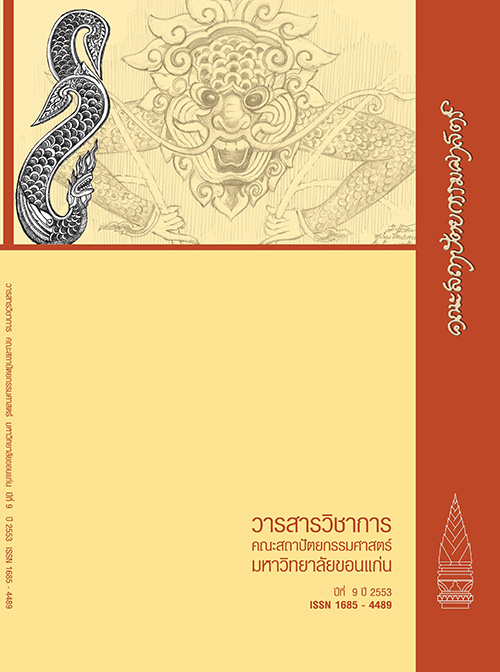อัตลักษณ์ในส่วนตกแต่งองค์ประกอบสถาปัตยกรรมศาสนาคารพื้นถิ่นไทยอีสาน กับ สปป.ลาว
คำสำคัญ:
ส่วนตกแต่ง, ศาสนาคารพื้นถิ่น, วัฒนธรรมไทยอีสาน-ลาว, Decoration, Local religious constructions, Thai Isaan-Lao cultureบทคัดย่อ
การศึกษานี้มุ่งค้นหา อัตลักษณ์เฉพาะถิ่น และ ลักษณะร่วม ตลอดจนคติความเชื่อ โดยเน้นศึกษาเฉพาะส่วนประณีตศิลป์ ของศาสนาคาร ประเภท สิม วิหาร หอแจก หอไตร มีขอบเขตพื้นที่10 จังหวัดในภาคอีสานเน้นที่ติดริมนํ้าโขงและ 8 แขวงของ สปป.ลาวตอนกลาง-ตอนล่าง ใช้วิธีการวิจัยเชิงคุณภาพ เน้นการสำรวจภาคสนาม ผลการศึกษา พบว่าสามารถจำแนกรูปแบบ ออกเป็น 1)สกุลช่างพื้นบ้าน 2)สกุลช่างพื้นเมือง 3)สกุลช่างญวน โดยสรุป อีสานและลาวมีฉันทลักษณ์ในเชิงช่างไม่แตกต่างกัน ยกเว้นในส่วนรายละเอียด โดยอีสานจะมีรูปแบบพื้นบ้านเป็นกระแสหลัก ขณะที่ สปป.ลาว แถบเวียงจันทน์ เป็นสกุลช่างหลวง ล้านช้าง โดยที่ลาวตอนล่างเป็นสกุลช่างพื้นบ้าน-พื้นเมือง ส่วนด้านคติความเชื่อพบว่าใช้กรอบแนวคิด นาคาคติ ที่แฝงอยู่ ในทุกมิติการสร้างสรรค์เหมือนกัน ด้านรูปแบบมีการผสมผสานทั้งวัฒนธรรมหลวงและวัฒนธรรมชาวบ้านที่เชี่ยวชาญงานไม้ ทั้งสายสกุลลุ่มนํ้าเจ้าพระยาและลุ่มนํ้าโขง รวมถึงสกุลช่างญวนที่มีความเชี่ยวชาญด้านงานปูนด้วยรูปแบบศิลปะจีนและฝรั่งเศส ทั้งหมดมีตัวแปรคือการเคลื่อนไหวของศิลปวิทยาการและการเมืองตลอดจนการค้าขายแลกเปลี่ยนทั้งหมดส่งอิทธิพลต่อ รูปแบบ งานช่าง และรสนิยมทางศิลปะทั้งไทยอีสานและสปป.ลาว
Identity in the Decorations of Local Religious Constructions of the Isaan Region of Thailand and Lao PDR
This study aimed to discover the local identity, mutual characteristics, as well as belief, focusing specifically on the elaboration art of certain kinds of religious constructions, namely, central sanctuary, vihara (monastery), charity pavilion, and scripture hall, of 1o provinces of the Isaan region adjacent to the Khong River and 8 provinces of central and southern Lao PDR. The research methodology employed was a qualitative one with emphasis on field survey. The result can be categorized into to 3 types: 1. school of local craftsmen, 2. school of native craftsmen and 3. school of Vietnamese craftsmen. In conclusion, the artistic conventions of Isaan and Laos are not different except the details. The style of Isaan craftsmanship is chiefly local, while that of the Vientiane area of Lao PDR belongs to the school of Lan Xang royal craftsmen and that of southern Laos belongs to the schools of local and native craftsmen. On belief, the Naga concept, which is inherent in every dimension of creativity, is commonly employed. On form, there is a combination of the royal culture and that of the commoners skilled in woodwork, both of the schools of the Chao Phraya River basin and of the Mekong River basin, as well as the Vietnamese school skilled in plaster work as apparent in the styles of Chinese and French arts. The variables among all the artwork are the movements of arts and sciences, politics and commerce. All these had influence on the artwork and artistic taste of both Thai Isaan and Lao PDR.
ดาวน์โหลด
รูปแบบการอ้างอิง
ฉบับ
ประเภทบทความ
สัญญาอนุญาต
ทัศนะและข้อคิดเห็นของบทความที่ปรากฏในวารสารฉบับนี้เป็นของผู้เขียนแต่ละท่าน ไม่ถือว่าเป็นทัศนะและความรับผิดชอบของกองบรรณาธิการ




